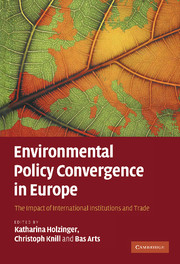Book contents
- Frontmatter
- Contents
- List of figures
- List of tables
- List of contributors
- Preface
- List of abbreviations
- 1 Introduction
- 2 State of the art – conceptualising environmental policy convergence
- 3 Theoretical framework: causal factors and convergence expectations
- 4 Research design, variables and data
- 5 Degree and direction of environmental policy convergence: analysis of aggregate data
- 6 The pair approach: what causes convergence of environmental policies?
- 7 The gap approach: what affects the direction of environmental policy convergence?
- 8 Conclusion
- Annex
- References
- Index
6 - The pair approach: what causes convergence of environmental policies?
Published online by Cambridge University Press: 22 September 2009
- Frontmatter
- Contents
- List of figures
- List of tables
- List of contributors
- Preface
- List of abbreviations
- 1 Introduction
- 2 State of the art – conceptualising environmental policy convergence
- 3 Theoretical framework: causal factors and convergence expectations
- 4 Research design, variables and data
- 5 Degree and direction of environmental policy convergence: analysis of aggregate data
- 6 The pair approach: what causes convergence of environmental policies?
- 7 The gap approach: what affects the direction of environmental policy convergence?
- 8 Conclusion
- Annex
- References
- Index
Summary
INTRODUCTION
The central objective of this chapter is to assess the influence of three international mechanisms on the convergence of environmental policies in Europe, namely international harmonisation, transnational communication and regulatory competition. In so doing, we apply a novel concept – the pair approach – for measuring and explaining convergence.
In this chapter, three central research questions underlying this study are addressed. First, on the basis of the pair approach, we provide further insights into the extent of cross‐national policy convergence, which complement the aggregate analysis in chapter 5. Second, and this is the primary concern of this chapter, we investigate the specific impact of economic and institutional interlinkages between nation states on policy convergence. Third, and related to this point, we are interested in the explanatory relevance of possible alternative explanations (in particular domestic factors) that were introduced in the theoretical part of this book (chapter 3). In answering these questions, we merely concentrate on potential changes in the similarity of individual environmental policies and of policy repertoires of countries over time. The direction of convergence, i.e., movements to the top or to the bottom of regulation, is not the subject of the analysis in this chapter, but will be analysed in chapter 7.
Our analysis is based on the following steps. We first introduce the concept of the pair approach (section 6.2).
- Type
- Chapter
- Information
- Environmental Policy Convergence in EuropeThe Impact of International Institutions and Trade, pp. 144 - 195Publisher: Cambridge University PressPrint publication year: 2008
- 8
- Cited by

